eISSN: 2469-2794


Review Article Volume 7 Issue 5
Nottingham Trent University School of Science & Technology, United Kingdom
Correspondence: Andrew O’Hagan, Senior Lecturer in Forensic Science, Nottingham Trent University School of Science & Technology, Clifton Lane, Nottingham, NG11 8NS, United Kingdom, Tel 07850875563
Received: September 26, 2019 | Published: October 4, 2019
Citation: O’Hagan A, Long A. The socioeconomic effects of organised crimes county lines on the United Kingdom community. Forensic Res Criminol Int J.2019;7(5):274-280. DOI: 10.15406/frcij.2019.07.00293
County lines is the transport of class a drugs from an urban city to a costal/rural town, this is achieved by a network of dedicated mobile phone lines. The groups use serious violence, intimidation and coercion to recruit vulnerable people, primarily children who will then transport the drugs to the desired area, as well as taking over their home through ‘cuckooing’. The rise of crime within the United Kingdom over the last 5 years can be linked to the expanding county line groups and the extreme violence they use to intimidate individuals, the soaring figures of knife crime and under 18 hospital admissions due to stabbing related injuries. The groups are difficult to follow due to the different transport routes available and how rapidly lines can be replaced to evade law enforcement. The under reporting of these crimes as well as the lack of public knowledge has led to the amount of lines doubling in size in the last 2 years, in order to combat this, vulnerable individuals should be safeguarded to prevent recruitment, as well as raising public awareness to increase public reporting and therefore increasing the amount of intelligence available to the police.
Keywords: county lines, modern slavery, heroine, crack cocaine, urban street gangs, organised crime, drug supply, drug runners, addiction.
EGYV, ending gang and youth violence; NCA, national crime agency; NSA, national strategic assessment; CSEA, child sexual exploitation and abuse; OIC, organised immigration crime; MSHT, Modern Slavery and Human Trafficking
Over the last 4 years from 2016 – 2019, there has been a surge of violence and crime that has swept through the nation leading police forces all over the United Kingdom to be stretched beyond their abilities. The crimes all vary but they all have violence as their common denominator. Street drugs are causing more deaths by poisoning now more than ever. Europe’s, cocaine purity is currently:1 the highest it’s been in the last decade,2 there were 3,756 drug poisoning deaths in 2017.3 Knife crime has increased severely and rapidly for the 4th year in a row, increasing by a dramatic 12% from 2017-2018.4 Out of the 43 police forces In England and Wales, 31 are now stating knife crime as a serious issue.4 Under 18’s admissions to hospitals for stabbing related injuries are the highest they’ve ever been. Criminal groups are transitioning to become nationwide organisations which all have a common motive to sell substances for a maximum profit. County lines is a relativity new way of transporting and selling drugs to a wider market, a group based in London could be selling their goods 200 miles away in Scarborough. The ways in which this is achieved is through the exploitation of vulnerable people, especially those who are young (ages of 12 upwards) and those who are addicted to drugs, crack cocaine or heroin especially.
The term cuckooing is often used to describe the incident when members of the county line groups invade and take control of an individual’s home through coercion, intimidation and sometimes violence. These individuals are typically vulnerable adults who either have a drug addiction, suffer with a mental illness or have a physical disability. County line’s is a growing issue within the United Kingdom and has been recognised by the National Crime Agency as a major threat within the drug threat assessment 2018.5 In 2017 – 2018 there were 720 county line groups recorded, the most recent data collection from 2018–2019 shows that there are now over 2,000 lines.6 An individual line is able to make up to £800,000 per year, creating a £5 million industry over the last couple of years.7 The rapid increase and growing volume of this crime has had a damming effect on the surrounding community, socially and economically. The lack of public knowledge causes the public to become a risk hazard to become part of the group’s recruitment process. Although safeguarding organisations have become apparent, such as Ending Gang and Youth Violence (EGYV), it’s only available in specific regions such as the urban hubs (London). It’s not yet available in the rural/coastal areas where the other side of the process is occurring. The lack of knowledge on these groups, both public and police and the ways in which they evade law enforcement has allowed them to grow dramatically over the last year.
Organised crime, as a whole, is a major threat within the United Kingdom. Over the last decade it’s grown in size and complexity and has a daily impact on public services and institutions. The organisation behind it allows activities to be undertaken that wouldn’t be possible for conventional criminals due to the coordination of the regional and national network.8 Organised crime is a broad topic that covers various elements, The National Crime Agency (NCA) creates a National Strategic Assessment (NSA) where the major threats for the U.K. are highlighted and placed into three pillars; Vulnerabilities, prosperity and commodities.9 Cross cutting threat enablers looks at aspects which cut across multiple threats.9 Vulnerabilities focuses on Child Sexual Exploitation and Abuse (CSEA), Organised Immigration Crime (OIC) and Modern Slavery and Human Trafficking (MSHT). Prosperity looks into money laundering, fraud and economic crimes, bribery and cybercrime commodities focuses on drugs and firearms. The cross-cutting threat enablers focuses on the vulnerabilities at the U.K. border, the use of technology in organised crime, repeat offenders and corruption within the U.K.9 A recent study by the NCA shows that there are currently 4,629 criminal gangs or syndicates operating in the U.K. which employ over 33,598 individuals. This ever-growing number is the reason why any other factors have had a sharp increase.
Over 200 organised crime groups are involved with modern slavery and human trafficking, this estimates to 10,000 people.10 The use of technology and the increase of its availability leads to the use of the dark web and encryption services. OCG’s will use live streaming services as a platform to make profits as users can be anonymous though the web, online child sex abuse has risen by 700% between 2014–2017, the British audience amounting to 80,000 people.11 County lines are essentially a drug supply network, which involves various elements of organised crime; MSHT, CSEA, firearms, drugs, money laundering and cybercrime. This problem affects all 43 polices forces within the U.K. and has been estimated to amount to £500 million of the drug industry.7 The drug industry in the U.K. has significantly increased. Purchases being made on the dark web have increased by 7% in 2017/2018,9 figure one shows death from drug poisoning by gender from 2015–2017. Production of drugs has increased in Colombia for cocaine and in Afghanistan for opium9 which causes the purity of the drugs to be higher. This has led to the increase in drug related deaths, in 2017 there were 2,593 deaths by drug misuse,12 432 deaths were due to the class A drug, cocaine.13 Figure 1 shows the death from drug poisoning from 2015–2017 recreated using data from office from (3).
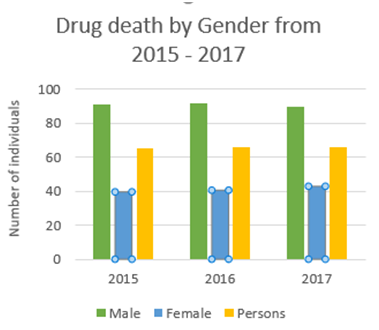
Figure 1 shows the death from drug poisoning from 2015–2017 recreated using data from office from 3.
Crack cocaine and heroin are two class A drugs that are increasing on the U.K. street market, this is due to the movement of drugs through county lines and they are highly addictive substances which have a high number of addicted users. Crack cocaine is a form of cocaine in rock style14 where a high is achieved through inhalation of vapours which Is done from heating the substance this is known as ‘free basing’.15 It has intense stimulant properties as it allows an increase of dopamine in the brain, this is short lived and only lasts 5–10 minutes. It’s appealed to more people during the last year due to the short time frame in which you can get high, this is due to the vapours quickly being absorbed from the lungs to the bloodstream.15 The number of people who have been treated for problems with this drug has increased by 44% from 2017–2018.14 Heroin is an opiate which is processed from morphine, it is naturally occurring in the seed pod which can be extracted from the opium poppy. There are many cuts of heroin, all of them dependant on the process in which It is formed. Impure heroin, most common in the U.K., is dissolved, diluted and then injected intravenously into the body to achieve a high.16 Once injected it will travel from the bloodstream to the brain and bind to the opiate receptors, this decreases GABA release.17
GABA normally inhibits dopamine release, as this has been decreased in GABA receptors causes an increase in dopamine which explains the quick high users feel.18 The emergence of county lines through urban street gangs – The emergence of county lines was identified in the National Strategic Assessment 2015,17 first focusing on urban street gangs. A gang can be defined as; ‘a predominantly street-based group of young people who:
Urbanisation within communities in cities led to intricate spaces becoming developed and youths who are vulnerable and are socially deprived will form peer groups of their own which progresses to the emergence of urban street gangs. They adapt their lives to follow a code of conduct, created by their peers which praises violent behaviour and criminal offences. The alternative authority allows them to operate in their own social field; which is based around social conflict.20 The summer riots in London 2011 prompted the home office to create the Ending Gang and Youth Violence (EGYV), this is an initiative which looks at three different stages; prevention of youths joining gangs, provide exit routes for those who want to leave a gang and appropriate enforcement responses to address challenges associated with gangs.21 A study of USGs by the home office in 2016 gathered statistics from 33 EGYV groups throughout the country.20 It states there is 3–8 gangs in each EQYV area which held more than 100 gang members, with an increase of USGs in London but a decrease out of London.
The membership of the gangs is highly fluid, with a majority of the members being linked to more than one gang. The report states that the youngest member is 11 years old and is mainly used to transport drugs around the country; younger children are preyed on by older members of the gangs due to their vulnerable circumstances such as a broken home or constant trouble at school. The promise of a lavish lifestyle is given when in reality they are taken away for several days to supply and transport drugs.20 The members of the gang are conformed to a hierarchal structure; the more senior members would hire the young adolescents to transport and sell drugs but also sexually exploit girls who have been lured into their captive hands. Drug supply is the main criminal activity that comes from USGs and it states that more gangs are now involved in the drug market when in comparison to two years ago, they have also become professional and therefore involved in crimes that are organised which are directed by senior criminals.20 These crimes are less visible to the public, covert operations performed by criminals are now done with ease due to the rise in technology, especially encryption methods on the internet which gives an the user an anonymous source.20
The national strategic assessment of serious organised crime 2016 states that USGs are a threat as they are distributing mid-market class A drugs to rural towns.17 The national strategic assessment of serious organised crime 2017 now calls this action ‘County Lines’ which is defined as; ‘the concept of county lines is the supply of drugs from urban hubs to county town…Usually being associated with urban street gangs’ This is now classed as a more serious threat which affects several counties and thousands of civilians.5 Typically, class A drugs are what USG will sell and transport to rural and coastal areas, the two main drugs being heroin and crack cocaine.5 The NSA in 2017 shows that in 2015 there were 3,674 deaths which related to drug poisoning, 2,479 of which involved illegal substances, this is the highest level since 2013.5
The term county lines were developed in 2016 when it was clear that urban street gangs were becoming more advanced and following the previously stated report by Disley and Liddle, the crimes committed were of an organised nature with more senior members were taking control and especially recruiting younger members. The concept of county lines is when gangs from large urban cities such as Birmingham, Liverpool and London want to expand operations to rural and coastal towns. The term county lines were developed in 2016 when it was clear that urban street gangs were becoming more advanced and following the previously stated report by Disley and Liddle, the crimes committed were of an organised nature with more senior members were taking control and especially recruiting younger members. The concept of county lines is when gangs from large urban cities such as Birmingham, Liverpool and London want to expand operations to rural and coastal towns (Figure 2).
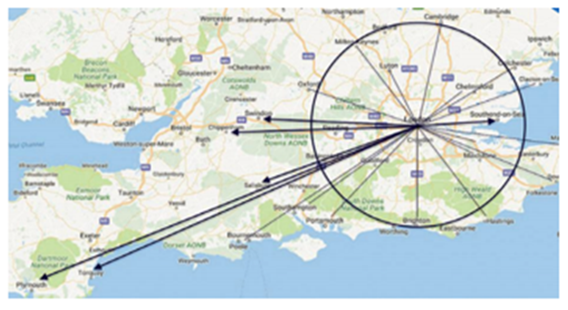
Figure 2 An image showing an example of the different ‘deal lines’ that come out of London. Image obtained via (22).
This is achieved through the use of branded phone lines, typically a message is sent out to a group of people who are known to be in the buying market for illegal drugs. This message indicates what’s available and through responses orders can then be placed. Another phone is used when the message is passed onto the dealers in the costal/rural marketplace; the excessive number of phone lines used is what makes these groups difficult to track. Vulnerable people and children are then exploited to take the drugs from the urban to the rural area and deliver them. The phone line is typically run by the senior members of the group.12 County line groups use high levels of intimidation and violence to control people who are involved, these levels of violence vary from firearms to knifes and in some cases sexual assault.12 As a report from the Home office states; ‘It's a major cross-cutting issue which involves drugs, violence, gangs, safeguarding, criminal and sexual exploitation, modern slavery and missing persons’.23 Drug runners are typically young adolescents, some as young as 11, who have been recruited through senior members. Young people are preyed upon with the promise of a lavish lifestyle or a higher social status.
Typically, children will be subject to these offers; with the use of social media it’s simple for individuals to be tracked and watched, the preparators can see how an individual’s life is unfolding from behind a screen. Children are targeted for many reasons, they may lack a stable home environment through the means of domestic violence, parental substance misuse, mental health issues and some cases criminality. Children who are part of a pupil referral unit and don't attend mainstream school or those who have connections with gangs can easily be manipulated into becoming recruited. Children who suffer with disabilities are also targeted along with those who suffer from social isolation, being accepted into group environment and being subsequently wanted and needed can give then a strong sense of purpose. This is also applicable to children who are in care; it gives them a sense of belonging.23 Both male and female children are targeted throughout this process, with white British children being targeted as they are more likely to evade police detection, gangs perception being that other ethnic minorities will be exploited.23 Some children join and don’t grasp the severity of what is happening. Others may now choose to do it for social status or to impress friends who are also part of the organisation. Peer pressure, the fear of missing out, to spite parents who are controlling; there are hundreds of reasons why they involved children in this organisation.
As they are drug runners who are involved in county line operations, its normal for them to get taken away from home and ordered to be a drug runner in a suburban location. For this reason it’s clear why more vulnerable children are targeted, as in theory, no one is looking for them. A case in 2018 shows a Birmingham drug dealer Z.M., being convicted for 14 years; 6 years for drug conspiracy and 8 for human trafficking under the modern slavery act 2015.24 He had recruited 3 individuals, 2 boys who were 15 and 1 girl who was 14, he took them from Birmingham to Lincoln which is 100 miles away and they were ordered to sell and distribute heroin and crack cocaine throughout the city.24 They resided in a flat along with heroin users which was deemed by police, unfit for humans to live in. When the police located them, they were in possession of several bundles of class A drugs and a substantial amount of money and hunting knives. This case was a landmark; Z.M. was the first individual to be convicted under the Modern Slavery Act 2015 for human trafficking when children are involved. An element that goes hand in hand with modern slavery is child criminal exploitation. This has no legal documentation through the use of organised crime groups, however Knowsley a safeguarding children board25 explains it as; ‘involves exploitative situations, contexts and relationships where young people, receive ‘something’ as a result of them completing a task on behalf of another individual or group of individuals; this is often of a criminal nature.
Child criminal exploitation occurs without the child’s immediate recognition, the child believing that they are in control. Those exploiting have power over them by virtue of their age, gender, intellect, physical strength and/or economic or other resources. Violence, coercion and intimidation are common.25 It's a combination of push and pull factors and how they gain control over individuals. Push factors being the individual supplying drugs, pull factors; giving the individual an escape from their life situation.25 Vulnerable adults are targeted for the same reasons; those who suffer with an addiction to substances, as well as those who suffer with mental health conditions and problems with their physical health, see (Figure 3).
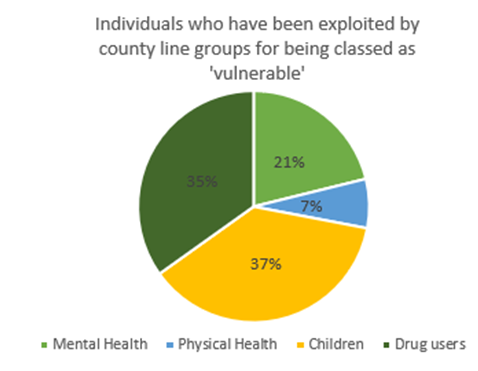
Figure 3 A pie chart which represents the type of vulnerable people country line groups exploit-data sourced from (5).
Adults who suffer from addiction are easy targets for these individuals they quickly and easily get involved in a debt bondage from using the drugs that had been provided and then owing money to the group. Cuckooing is a term used when a person’s house is taken over by drug dealer they use the house to store their drugs and the proceeds as well as other illegal items. This tends to happen to those who are suffering from mental health issues, those who are disabled or those who have a severe addiction. Vulnerable women are targets for sexual abuse, they will either pay for their drugs by engaging in sexual activity or by order of the drug dealer, sell themselves in a house that has been taken over by cuckooing (Figure 3). This also occurs with younger members, In 2017, 500 cases of girls under the age of 18 were referred to the Home Office for sexual exploitation, this was ‘up more than 250% when in comparison to the last three years’.26 65% of U.K. forces stated in 2017 that there was exploitation of children, 42% of which were ‘runners’ and 26% were being sexually abused.18
A case that started in 2017 has recently led to convictions, 9 individuals were jailed for conspiracy to supply class A drugs, crack cocaine and heroin.27 The police raid during this operation found 6 mobile phones, all of which were being used as the lines, this particular line was known as the ‘deno’ line and over 45,000 messages were found between these mobiles27 which shows the scale & how well adapted some groups can be. This case was operational for 5 years and within the 1st half of 2018 1kg of crack cocaine and heroin was sold to its buyers.27 The base of this operation was in East London and it reached to Great Yarmouth, the supplies were transported through taxis from London to Great Yarmouth where it would be stored in house that has been taken over (cuckooed) by the managers of the operation.27 The houses belonged to 6 women, all addicts and 3 of which had exchanged the use of their houses for drugs. This case highlights all the different key aspects of county lines Figure 4 shows the organisation behind the Deno Line. Another county line group was dismantled by North Yorkshire police In October 2018, which resulted in the arrest of 10 individuals whose charges amounted to 37 years. They were charged with conspiracy to supply crack cocaine, heroin and money laundering.29 Thomas Dean was head of the group and is a reoffender, leaving prison in 2016 after gaining similar charges to the ones he’s now faced with. He moved to Scarborough to recruit individuals to supply drugs whilst using violence to intimidate.29
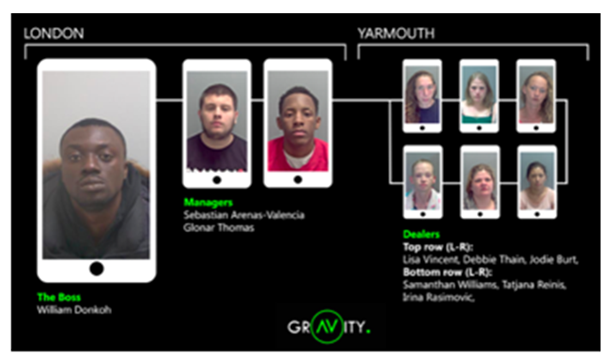
Figure 4 Image of ‘Deano’ line, showing the ‘boss’, managers and dealers. Image obtained from-Norfolk Constabulary website (28).
Gang violence has increased rapidly over the last ten years hand in hand with the emergence of county lines. County lines groups pose a significant threat towards vulnerable people, they are prone to forms of extreme violence with the use of weapons and firearms.12 There have been incidents of serious violence, threats to kill and homicide. Knife crime has risen rapidly over the past years, with some of the highest recorded figures occurring in 2018. In 2018 from January to November there were 272 fatal stabbings and 1,800 reported knife attacks throughout the U.K.30 These figures have only been this high once before which was in 1947. Under Section 1 of Prevention of Crime Act 1953 its unlawful for any persons to have an offensive weapon,31 despite this law in 2017-2018 14,769 knife crime cases were reported.30 Figures 5 & 6 both shows statistics from 2013 up to 2018 which all involve sharp objects, those mainly being a knife the visual output from the graph instantly shows the growing increase over the last 6 years.26
Assault with injury and intent to cause serious harm has had a significant increase from 17,683 in 2016 – 2017 to 18,787 in 2017 -2018, county lines groups use violence to intimidate and control other members of the group. From looking at the increase in deaths and injury over the last 6 years and looking at the increase in hospital figures in the last two years, these elements are not improving and are having a horrific effect on the community as a whole, straining various resources. Drug poisoning and knife deaths are at an all-time high (Figure 5). The nation’s main city is a central hub, its bustling streets in the day the chaotic scene’s at night. It’s now become known as a place that retrospectively isn’t ideal for the adolescent age group due to the pull factors of certain crime groups. What seems like a quick way to make money can quickly turn into a fight for a life. Knife crime, especially in the under 18 age group has increased by 93% in the last 5 years.32 This age group has become a great concern for the dramatic increase of figures over the last 5 years, some increasing by 50% such as in (Figure 3), the increase in hospital admissions have gone up dramatically. In 2012-2013 180 under 18’s was admitted to hospital following a sharp’s incident, in 2017-2018 that figure has doubled to 347 (32). Turf wars can cause major disputes between youths who are operating as part of a criminal group. In London 2017, it was estimated that there were 4,500 individuals involved in 250 gangs (Figure 6).33
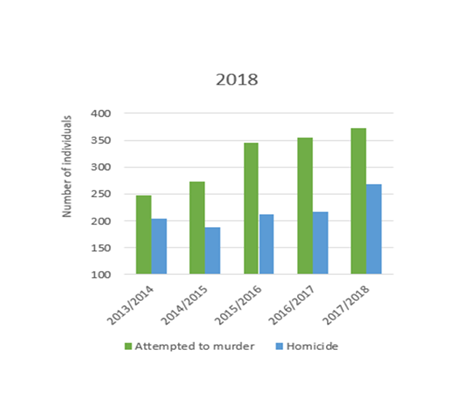
Figure 5 Comparative analysis from 2013-2018 on number of incidents where an attempted murder or murder has taken place, data achieved by recreating statistics from (30).
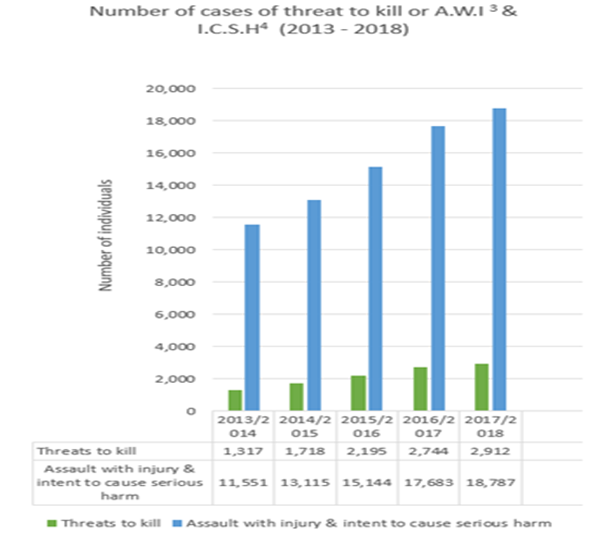
Figure 6 Comparative analysis from 2013-2018 on number of incidents where assault with injury & intent to cause harm or threat to kill has been made, data achieved by recreating statistics from (30) (see graph12,13).
County line groups are noted as being extremely violent and intimidating, often using violence and inflicting ABH & GBH on individuals. The young girls that are employed as runners can be subject to sexual assault and rape, extreme violence is used in these circumstances and instances where a knife has been used in these have increased by 38%.32 This also applies to vulnerable adults who are addicted, especially those who’s houses have been cuckooed and is now a base for the drugs. The most dramatic increase is the use of a knife during a robbery, although not all county lines can account for this increase, a large proportion can.34 This is due to turf wars occurring in areas where ‘traditional’ drug dealers and county line dealers work in the same area. Invading each other’s spaces caused a loss of profit on both parties, violence is often used to settle these disputes. This adds to the increase of knife crime and deaths, they also take items from the retrospective group so no profits are made an increase of 50% which leads to there being 999 cases of robbery with a knife.32 This statistic goes to show that individuals are adapting, and they are not afraid of the consequences of having a weapon in their possession.
This is reflected in the amount of homicides by knife, from 2016 – 2018, an increase of 77% with under 18’s homicides in 2016 being 26 and in 2018 an alarming 46.32 The increasing amount of under 18’s who have died due to the result of a knife reflects the issue. Vulnerable young people are getting drawn into the county lines group and not being able to leave, as the violence increases the ways in which they protect themselves will adapt. As a result more weapons are used, which in some cases, when another individual is more armed or experienced, will lead to the death of a young individual (Figure 7).
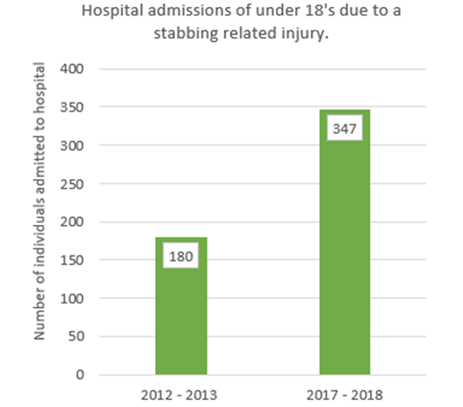
Figure 7 Number of hospital admissions comparison of under 18’s due to a stabbing related injury, data sourced from (32).
An individual named Stacey became part of gang at the age of 10, over ten years ago.26 She states in an interview that although county lines and gang culture have ‘completely developed’ since then, the media attention which is now given to these elements are helping to reduce it. From media attention; charities and organisations are being formed as well as funded government organisations such as the National County Lines Coordination Centre, which became active on 21st September 2018.35 Stacey states that although these new initiatives are working well in the present day, prevention didn't occur 10 years ago. The county line groups have developed and increased in an alarming manner since 2015 and alarmingly over the last year. This shows that prevention is a key to combat these issues and that a nation-wide police approach is the best way forward. This has started with the implication of the National County Lines Coordination Centre which in January 2019 conducted its first intelligence-based search.36 This gave police the authority to search addresses that were suspect and also visit vulnerable individuals, it led to £200,000 worth of cash being found, a substantial amount of drugs as well as a number of weapons including firearms.36 It’s been noted that 118 county line groups have access and use firearms.6 The investigation conducted also had the ability to protect 400 vulnerable adults and 600 children.36 These figures show how large and complex these groups can be, protection of 1,000 individual’s in a 6-day period. The serious violence strategy of 2018 has aims set out to reduce the amount of crime within the U.K. by using prevention methods. These aim to steer young people away from a life of crime, but they promote the role of a strong law enforcement.37 £17.7 million is being used to create 29 projects to support early intervention youth fund.37
Providing a national, regional and local approach to county line groups will ensure that the ways in which individuals are dealt with in a systematic fashion. The 4 P’s (protect, prevent, pursue, prepare) are the ideal strategy to apply to this situation. Incorporating the 4 P’s into these approaches will help with the continuity throughout the nation, as county lines occur all over the U.K.. Having a similar approach to dealing with these issues nationwide will avoid confusion between forces and allow similar approaches to tackle them. Protect the vulnerable individuals, prevent the individual from becoming part of the process; prepare information to give to the public to inform them and pursue the county line groups who are exploiting vulnerable people. Through this approach you would be able to target the highest-ranking member of the group. By doing this, often the group will collapse. However, the most import factor in looking forward is public knowledge and protection of vulnerable people. This can be achieved through multiagency safeguarding throughout the U.K. though the use of information sharing, as ‘runner’ can visit multiple places depending where the line run, shown previously in (Figure 2). Building resistance and early intervention of children will prevent them from becoming part of the group. Giving the public more information on county line groups will give them the courage to then report suspicious activities. This will then help law enforcement gather more intelligence to tackle the issues of county lines.
In conclusion, it’s clear to see that county lines have had a perplexing effect on the community since they emerged. Their growing numbers lead to an increase of crime in many areas such as modern slavery, cyber-crime, money laundering and the overall increase of drugs on the street. Specifically, in the past two years (2018/2019) there has been a significant increase in knife crime within the U.K., particularly in London. London, as previously stated, is the main hub for county line group dealings with a majority of ‘lines’ running from the centre. An astounding 272 fatal stabbings, 1,800 reported knife attacks and 14,769 knife crimes were reported in 2017-2018, these current statistics are at an all-time high. NHS resources are stretched due to the increase of fatal stabbings and violence used upon each other, rising 14% in the last two years, with 34% of patients being rushed to hospital with life threatening injuries from stabbing related injuries.38,39 Police reports are increasingly worried about the number of under 18’s becoming involved with criminal groups.
Under 18’s having fatal stab injuries has increased by 25%, this dramatic increase over the last 4 years is worrying for various reasons but it also highlights how dangerous these groups can be and how easily youths are pulled towards them.40,41 All 43 police forces in England and Wales are now affected by the threat of county line groups and the trouble that they can bring to an area. Although prevention methods have begun, in order for them to start to have an effect on the issue they need to be available nationwide in all police forces. They should especially be available in local councils and implement in certain schools in big cities or those schools which have a specialised area which aids vulnerable children. The effect that county lines have had on the community is devastating and is a problem that will continue to grow if the right precautions aren’t followed. Vulnerable adults and children have to have a more controlled safeguarding situation which will prevent and protect them from getting involved with county line groups. The prevention of children becoming involved will decrease the amount of lines rapidly if prevention methods are functioning. The knowledge to the public will eventually increase police intelligence to tackle and dismantle county line groups.
None.
The author declares that there are no conflicts of interest.

©2019 O’Hagan, et al. This is an open access article distributed under the terms of the, which permits unrestricted use, distribution, and build upon your work non-commercially.